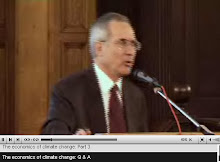
Energy Producing Roads made from solar cells and glass may be the solution to carbon emissions and climate change.
Background
Although Scott Brusaw's company, Solar Roadways, is based out of his house in Idaho and in the home electronics workshop he built next to it with the income from his consulting, it may hold the key to solving climate change and global warming.
Background
Although Scott Brusaw's company, Solar Roadways, is based out of his house in Idaho and in the home electronics workshop he built next to it with the income from his consulting, it may hold the key to solving climate change and global warming.
Solar Roadways is still in the concept phase, built on Brusaw’s childhood fascination with an electric race car game called slot cars. The idea of cars running on electric roads stayed with him as he went on to earn his Master's degree in electrical engineering. As global warming became established science, his wife Julie suggested he turn his obsession with electric roads into a way to conserve fuel and reduce pollution. Brusaw came up with the idea of a road that produced its own electricity, a solar highway for energy independence.
One of the nation's leading authorities on solar energy, Nate Lewis of Caltech, has calculated that covering 1.7% of the land surface of the United States with 10 percent efficient solar energy converters could supply all our current national energy demand. As it happens, this is roughly the same amount of land that is devoted to the nation's interstate highway system. Lewis believes that covering a large, barren section of some of the western states with solar panels is the best solution to our energy needs, but we would need a photovoltaic material almost as cheap as paint to make it cost competitive with fossil fuels, and we would still need to transport the energy around the country.
In Brusaw's Solar Roadways concept, instead of covering a large area of the Southwest with solar arrays, all of our roads would be paved with glass panels that could collect and distribute solar energy. Sunlight would shine through the surface onto a middle layer of solar cells. The solar cells would produce electric energy to light the road at night and heat it in winter, with enough leftover electricity to power homes and businesses. Brusaw estimates that each mile of solar panels could power 500 homes.
Brusaw's Rationale for Solar Roadways includes:
· 4.84 billion (12' by 12') Solar Road Panels would be required to replace the current asphalt road system, parking lots, and driveways in the 48 contiguous states. This is enough to provide three times more electricity than the United States used in 2003 and almost enough to supply the entire world.
· To produce a Solar Roadway Panel (not including assembly and installation) would cost approximately $5,000 for materials. Solar cell cost and efficiency is predicted to improve dramatically with thin film technologies in the next few years.
· Cost to build enough coal-fired power plants to provide a similar amount of electricity - approx. $14 trillion.
· The cost of Global Warming is unknown, but could reach 5% to 20% of global gross domestic product annually, according to the Stern Review on the Economics of Climate Change.
To answer the energy transport needs, the roadway's base layer would contain the nation's electric grid, safe from weather and secure from interruption, replacing the current crumbling power grid with a distributed network of independent power sources providing energy from coast to coast. Along with electricity, the base layer could also carry fiber optic cables for television, communication, and high speed Internet so that cities and rural areas would be equally connected and the ugly poles and wires that clutter our landscape could be removed. Smart roadways could reconfigure travel lanes to reduce gridlock, warn drivers of construction or obstacles ahead, sense whiteouts or other weather conditions, and even keep wildlife off the roads. In Brusaw's scheme, heated and lighted roadways would make travelling safer and save lives.
Most of the technologies required for the base and middle layers are already available, Brusaw told the glass scientists and industry reps at a Washington workshop. With only a minute of his allotted time remaining, he summarized his challenges to the scientists and manufacturers: Build a transparent glass panel that absorbs sunlight without any glare, lit by low energy LEDs from within, with heating elements to melt ice and snow and a surface both fireproof and shatterproof with traction equal to asphalt, even when wet, with the ability to withstand road salt, magnesium chloride, sun exposure, vehicle emissions such as antifreeze and oil, and the strength and flexibility to handle heavy trucks. And finally, in order to make the project economically feasible, the glass should last about three times as long as most asphalt roads, he concluded.
Creating solar roadways may be possible with some new enabling technologies. These new technologies include new types of self-cleaning windows with microstructures based on the lotus flower's ability to shed water, and recent breakthroughs in superconducting transmission cables cooled by liquid nitrogen that carried five times the current of standard cables.
Source: Pennsylvania State University Materials Research Institute





Ingen kommentarer:
Send en kommentar